Understanding the Nuances of Shoeing Gaited Horses
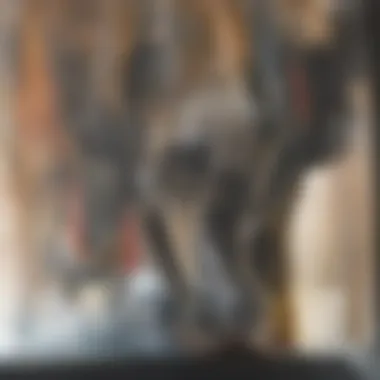

Intro
Shoe selection for gaited horses is not a trivial exercise. It demands a comprehensive understanding of equine biomechanics and the unique movement patterns of these breeds. The nuances of shoeing affect performance, comfort, and overall welfare. Gaited horses, like Tennessee Walking Horses and Paso Finos, are distinct in their movement, necessitating specific approaches during the shoeing process. This article explores various elements of shoeing gaited horses, examining how shoe choices and farriery techniques can significantly influence their performance.
Research Context
Background and Rationale
Understanding the intricacies of shoeing gaited horses is crucial for trainers, owners, and farriers. The unique gait of these horses, characterized by fluid and efficient movements, can be compromised by improper shoeing. Since the biomechanics of gaited horses differs from that of non-gaited breeds, it is essential to evaluate shoeing practices effectively. This ensures not only optimal performance in competitions but also the health and comfort of the horse in daily use.
Literature Review
Existing literature provides substantial insights into shoeing practices for various horse types, but specific focus on gaited horses often remains superficial. Studies indicate that incorrect shoeing may lead to issues such as hoof breakage, lameness, and muscle strain. Sources such as the Journal of Equine Veterinary Science and Equus Magazine detail innovative approaches in farriery tailored to gaited breeds. Despite this knowledge, a gap exists between research and practical application, highlighting the need for this article to synthesize existing information and provide actionable insights.
Methodology
Research Design
This article employs a qualitative research design, examining various methodologies used in the shoeing of gaited horses. It draws from a combination of peer-reviewed studies, expert interviews, and anecdotal evidence from seasoned farriers and trainers. The aim is to create a holistic perspective that is both informative and practical.
Data Collection Methods
Data was collected through several means:
- Review of academic literature on equine biomechanics
- Analysis of case studies involving different shoe types
- Interviews with farriers specializing in gaited horses
- Surveys distributed to horse trainers and owners focusing on grooming practices
Through this multifaceted approach, the article provides a well-rounded understanding of how shoeing impacts the health and performance of gaited horses.
Understanding Gaited Horses
In the realm of equine husbandry, understanding gaited horses is paramount for those who work with this specific subset of breeds. The nuances of their movement patterns influence not only the type of training they require but also the manner in which they need to be shod. It is crucial to recognize that gaited horses possess distinct biomechanics compared to their non-gaited counterparts. This understanding directly impacts farriery, performance, and overall welfare of the horse.
Gaited horses are bred for specific riding styles, often reflecting their cultural origins. With their unique gaits, they can provide a smoother, more comfortable ride. This quality is particularly advantageous for riders who may have physical limitations or seek to travel longer distances comfortably. Beyond physical aspects, understanding the behavior and temperament of gaited horses also plays a significant role.
Moreover, considerations related to shoeing become integral to ensuring these horses achieve their potential. Factors such as the horse’s conformation, the type of foot they have, and the kind of work they are expected to perform all necessitate a tailored approach to shoeing. Recognizing these characteristics allows horse owners and farriers to make informed decisions that support performance and mitigate risks of injury.
Defining Gaited Horses
Gaited horses are recognized for their ability to perform a variety of distinctive gaits, each characterized by unique sequence of footfalls. Unlike standard horses that typically walk, trot, canter, and gallop, gaited horses perform additional gaits such as the running walk, fox trot, or tölt. These gaits are smooth and easy on the rider, making them favorable for many equestrians.
Understanding what defines gaited horses involves becoming familiar with their physical attributes and genetic lineage. Specific conformation traits often aid in executing their unique gaits. Aside from physical traits, their breeding history is rich, with many originating from regions where smooth-riding capabilities were paramount. This heritage plays a critical role in their current purpose and usage.
Common Breeds of Gaited Horses
Tennessee Walking Horse
The Tennessee Walking Horse is one of the most well-known gaited breeds. Its defining characteristic is the unique running walk, which is a four-beat gait offering a smooth, gliding motion. This breed is popular for both recreational riding and competitive showing. The Tennessee Walking Horse's calm disposition also makes it a favorable choice, especially for novice riders.
The unique ability of this breed to maintain speed while being smooth is its greatest advantage. However, some may face challenges with maintaining good foot health under certain training conditions. Proper shoeing helps to mitigate these issues, emphasizing the need for farriery that supports both performance and soundness.
Missouri Fox Trotter
The Missouri Fox Trotter exhibits a naturally unique gait known for its distinctive two-beat rhythm, often described as a "fox trot." This gait allows for comfort and efficiency, making it suitable for long-distance riding. Its versatility extends to disciplines such as trail riding and ranch work, proving its adaptability in various environments.
What makes the Missouri Fox Trotter appealing is its combination of the smoothness of movement and the ability to cover ground effectively. Nevertheless, as with many gaited breeds, they too may have concerns regarding foot care. Understanding the Missouri Fox Trotter's unique requirements ensures that they perform optimally without risking injury.
Icelandic Horse
The Icelandic Horse stands out with its unique, additional gaits, such as the tölt and pace. These attributes derive from the breed’s historical breeding for endurance and versatility. Its small stature and robust build are conducive to both agile movement and stamina, qualities that many riders appreciate.
The tölt, in particular, allows for an exceptionally smooth ride, which can be beneficial for pleasure riding and traditional Icelandic competitions. However, due to its adaptability to rugged terrain and traditional uses, proper shoeing plays an essential role in maintaining foot health and performance levels. Understanding these traits leads to better decision-making regarding farriery and training options for horse owners.
Biomechanics of Gaited Horses
Understanding the biomechanics of gaited horses is crucial for optimizing their performance and maintaining their overall well-being. This area explores how horses move, the physics behind their locomotion, and the practices that can either enhance or diminish their natural abilities. The focus on biomechanics allows farriers, trainers, and owners to make informed decisions regarding shoeing, which can significantly impact movement efficiency, comfort, and injury prevention for these unique breeds.
Movement Patterns
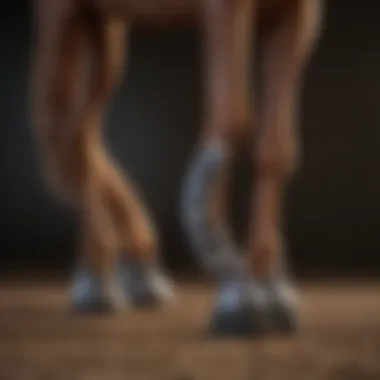
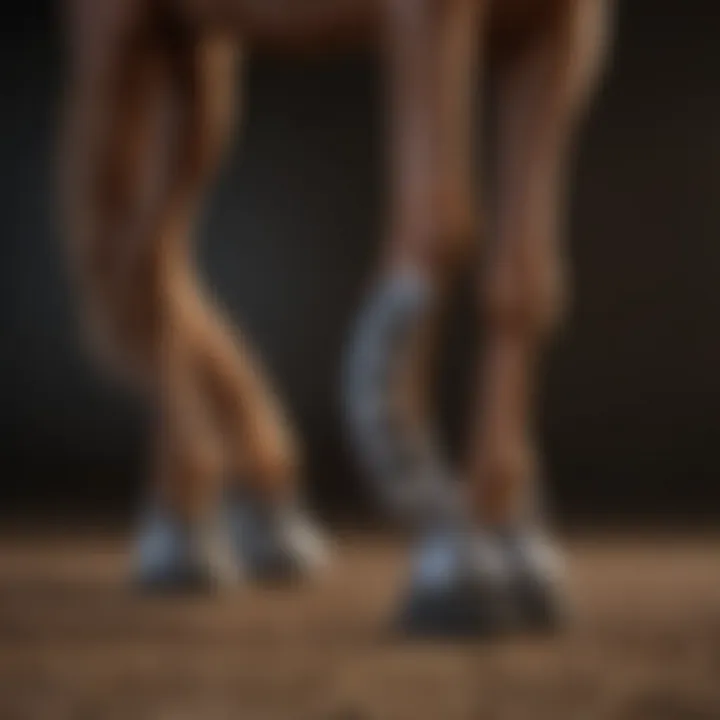
Gaited horses possess distinctive movement patterns that set them apart from non-gaited horses. Breeds such as the Tennessee Walking Horse and Missouri Fox Trotter showcase specialized gaits like the running walk and fox trot. These movements involve intricate coordination between the horse's limbs and body, allowing for smooth transitions and a unique rhythm.
Properly understanding these movement patterns is essential when shoeing these horses. A well-fitted shoe can facilitate the natural gaits, thereby reducing strain on muscles and joints. Careful consideration of the horse's movement must be matched with shoe selection, ensuring that the shoes contribute positively to the horse’s biomechanics.
Notably, alterations in shoe weight and design can impact how the horse moves. For instance, a heavy shoe may impede the fluidity of a gaited horse's motion, leading to potential discomfort or performance decline. In contrast, lightweight, appropriately designed shoes allow the horse to maintain its characteristic gait without compromising efficiency.
Impact of Conformation on Gait
The conformation of a gaited horse plays a pivotal role in defining its gait mechanics. Features such as leg length, hoof shape, and overall body structure contribute significantly to how the horse interacts with the ground during movement. For example, horses with a sloped shoulder tend to have a longer stride compared to those with a more upright shoulder, affecting their overall performance and movement style.
Specific conformational attributes may also predispose horses to certain issues when poorly shod. Horses with upright pasterns often experience more concussion, which can be exacerbated by improper shoeing techniques or unsuitable shoe types.
In summary, the intricate connection between conformation and gait mechanics necessitates a tailored approach to shoeing. Farriers must assess each horse's individual anatomy to ensure that the shoeing complements its unique structural characteristics. This attention to detail not only enhances performance but also mitigates risks associated with joint stress and potential injuries.
Proper biomechanics are essential for maintaining the health and performance of gaited horses.
Through careful examination of movement patterns and the influence of conformation, farriers can significantly improve the welfare and efficiency of gaited horses. A comprehensive understanding of these biomechanics is thus indispensable for anyone involved in the care and training of these remarkable animals.
Importance of Proper Shoeing
The shoeing of gaited horses is a critical component in ensuring their performance and welfare. Understanding the importance of proper shoeing goes beyond merely attaching a shoe to a horse's hoof. It encompasses the art and science of enhancing a horse's natural capabilities. This section will elaborate on key elements related to the importance of proper shoeing for gaited horses, including its effects on performance and preventive measures against injury.
Effects on Performance
Proper shoeing can significantly influence a gaited horse's performance. The type of shoe, its weight, and the way it is fitted can contribute to the horse's gait, stride length, and overall agility.
- Shoe Design: The design of the shoe should complement the horse's natural gait. For instance, sliding shoes may benefit those horses that exhibit a specific gliding movement in their stride, while more traditional shoes may be needed for other gaits.
- Weight Consideration: A lighter shoe can help in maintaining high speed, whereas a heavier shoe may provide additional stability when needed.
- Foot Health: Proper shoeing helps maintain healthy hooves. A well-fitted shoe can prevent hoof cracks and other issues, thus allowing the horse to perform to its fullest potential.
Ultimately, a horse that is correctly shod will not only perform better, but will also have enhanced comfort and a more enjoyable riding experience.
Preventive Measures Against Injury
Injury prevention is a fundamental aspect of shoeing gaited horses. A horse's hooves are subjected to various stresses during activities. Without proper shoeing, these stresses can lead to injuries and long-term issues.
- Common Injuries: Lameness, hoof cracks, and abscesses can emerge from improper shoeing techniques. Recognizing the signs early on is vital.
- Shock Absorption: Shoes can provide essential shock absorption, which is especially important for gaited horses that perform vigorous maneuvers. This reduces the risk of injuries not only to the hooves but also to legs and joints.
- Regular Maintenance: Consistent farrier visits are crucial for monitoring hoof health. Adjustments in shoeing should be made as per the horse's evolving needs.
"Proper shoeing is not just a necessity, but a fundamental part of nurturing equine athletes."
Types of Shoes for Gaited Horses
Understanding the types of shoes available for gaited horses is crucial for both their performance and overall well-being. Each type of shoe serves specific functions, catering to the unique needs of these horses. The right choice of shoe can enhance movement efficiency and provide necessary support, while improper selection may lead to discomfort or injury. Therefore, knowing the options allows horse owners and farriers to make informed decisions that benefit both horse and rider.
Steel Shoes
Steel shoes are among the most traditional and widely used types of footwear for gaited horses. Their durability is a key advantage, providing long-lasting support especially on rugged terrain. Steel shoes are heavier than alternative materials, which can offer improved traction and stability under various conditions.
Another significant benefit is ease of repair. If a shoe becomes damaged, it is relatively simple to replace or fix steel shoes compared to those made from lighter materials. However, the additional weight can be a drawback during specific movements, potentially hindering performance in some gaited breeds. Thus, assessing the specific needs of the horse is essential when considering steel shoes.
Aluminum Shoes
Aluminum shoes are gaining popularity in the equine world, particularly for performance horses. The lightweight nature of aluminum significantly reduces the overall weight on the horse's legs, allowing for increased agility and faster movements. This can be beneficial for gaited breeds that rely heavily on fluid, efficient motion.
Also, aluminum shoes can be easily customized with various shapes and sizes to meet the specific requirements of individual horses. However, they may wear out more quickly than steel shoes, especially in rough environments. Therefore, regular inspections and replacements are crucial when using aluminum footwear to ensure the continued well-being of the horse.
Specialty Shoes
Specialty shoes address specific biomechanical problems or performance needs in gaited horses. Among these are two well-known variants:
Egg Bar Shoes
Egg bar shoes play a unique role in supporting hoof function, especially in horses with specific issues like navicular disease or other heel-related problems. Their distinctive design helps distribute weight more evenly, reducing pressure on sensitive areas of the hoof. This can enhance comfort for horses that may struggle with traditional shoe types.
A key characteristic of egg bar shoes is their extended toe and heel, which can offer added support. This can be especially beneficial for horses requiring additional balance during gaiting. However, a disadvantage is that they may not be suitable for all horses, particularly those with normal conformation. Overall, their use should be a carefully considered decision by the farrier and owner alike.
Heart Bar Shoes
Heart bar shoes are another specialty option, often used for horses suffering from laminitis or other hoof concerns. The shoe's design features a bar that runs across the shoe's heel area, providing support to the frog and aiding in load distribution.
These shoes can alleviate stress on the hoof wall and promote circulation, critical for healing in problematic cases. Their unique feature distinguishes them from traditional shoes and serves as a preventive measure against further injury. Still, just like egg bar shoes, heart bar shoes require proper fitting and expertise to avoid complications. The success of a treatment plan often hinges on the farrier's skills and understanding of the horse's specific conditions.
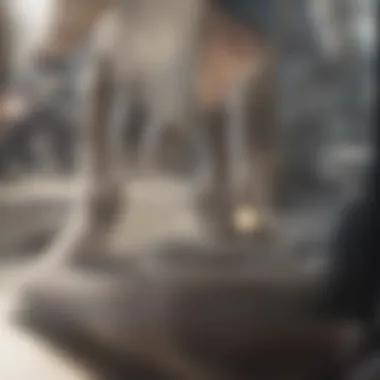
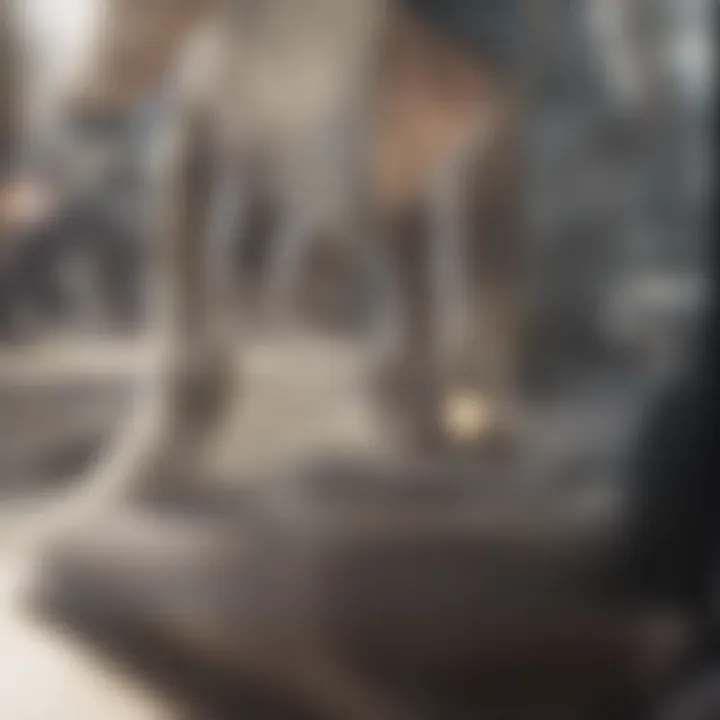
In summary, understanding the various types of shoes available for gaited horses enriches the knowledge needed to optimize their care and performance. Selecting the right type depends on the horse's needs, surface conditions, and the specific issues that may arise.
Farriery Techniques
Farriery techniques are essential for maintaining the health and performance of gaited horses. Proper farriery ensures the horse's hooves are well-maintained, which is crucial for their unique movement patterns. The techniques employed by farriers significantly influence not just the horse's gait but also its overall welfare. It is important for horse owners to understand these techniques, as it helps in making informed decisions regarding hoof care.
Trimming Techniques
Trimming is a fundamental aspect of farriery that plays a pivotal role in the maintenance of a gaited horse's hooves. The trimming process involves removing excess hoof material to ensure balance and support for the horse’s unique gait. Gaited horses, like the Tennessee Walking Horse or Missouri Fox Trotter, often require special attention due to their specific movement patterns.
Key Considerations for Trimming:
- Frequency of Trimming: Regular trimming is crucial, typically every six to eight weeks, to prevent overgrowth and related issues.
- Balance: A well-balanced hoof promotes proper biomechanics, enhancing performance and reducing the risk of injury.
- Angle: Maintaining the correct angle is key for improving efficiency and reducing strain on tendons and ligaments.
- Weight Distribution: Ensuring even weight distribution across the hoof helps maintain soundness.
A farrier must evaluate the horse's movement and conformation to determine the proper trimming approach. This might involve adjusting the length of the heels or the weight-bearing surface of the hoof to suit the horse's gait characteristics.
Nailing Patterns
The nailing pattern used when applying shoes to gaited horses is another vital aspect of farriery. Different nailing techniques can significantly influence how a horse performs. Properly executed nailing not only secures the shoe but also allows for natural flexibility and movement.
Typical considerations in nailing patterns include:
- Placement of Nails: The nails should be placed so they do not interfere with sensitive areas of the hoof, such as the laminae or the frogs.
- Number of Nails: Adequate, but not excessive, nails are used to secure the shoe while allowing for hoof expansion.
- Angle of Nails: The angle determines how the shoe sits on the hoof and can impact the horse's gait and comfort.
It is common to see preferences among farriers based on their experience and the specific requirements of each horse. Some may choose to use clips in addition to nails for added security, particularly for horses that may be more prone to losing shoes during rigorous activities.
"Understanding the nuances of farriery is vital for optimizing the health and performance of gaited horses."
In summary, both trimming techniques and nailing patterns are central to effective farriery practices tailored for gaited horses. Owners and trainers should collaborate closely with experienced farriers to ensure their horses receive the best care possible, which can lead to significant improvements in movement, comfort, and overall health.
Regional Differences in Farriery
Understanding the regional differences in farriery is crucial for effectively shoeing gaited horses. Various geographical areas adapt their techniques according to local horse breeds, terrain, and climatic conditions. This adaptability addresses the unique biomechanics and behaviors of gaited horses. Also, a regional approach ensures that shoeing practices meet not just performance needs, but also the welfare of the horse.
Both North American and European practices showcase distinct philosophies shaped by the specific demands of their environments. These methods directly influence the choice of materials, shoeing techniques, and farrier-client interactions. Horse owners and farriers must recognize these differences to optimize care and enhance the gaited horses' performance.
"Regional practices provide insights into how local conditions shape farriery, promoting a more tailored approach to horse care."
North American Practices
North America has a diverse landscape of farriery practices influenced by a variety of factors. The vast geographical diversity leads to different needs based on climate, terrain, and even the breed of horses. Farriers in this region often employ a practical approach. They emphasize utility and function over aesthetics.
Common practices include:
- Use of Steel and Aluminum Shoes: These materials are popular due to their availability and durability. Farriers choose them based on the horse's activities.
- Focus on Soundness: Many North American farriers prioritize the overall soundness and health of the horse's feet. They incorporate regular consultations with veterinarians.
- Nailing Patterns: Most farriers adopt standardized nailing patterns that consider the hoof structure of gaited breeds, providing necessary support while limiting stress.
This regional approach allows farriers to adapt to the unique characteristics of gaited horses, thus enhancing their performance while minimizing injury risks.
European Farriery Techniques
In Europe, farriery tends to incorporate traditional practices alongside modern innovations. The approach here is often more holistic, considering not just the shoeing but also the horse's overall well-being. Techniques may vary significantly between countries because of cultural differences in horse care.
Key elements of European practices include:
- Emphasis on Hoof Health: European farriers often focus more on the health of the hoof than on aesthetics. They look for ways to enhance the natural function of the hoof.
- Diverse Shoe Types: Europe offers a wider variety of specialized shoes, especially for gaited horses, including custom options tailored to individual horse needs.
- Integration of Technology: Some European farriers utilize advanced technology, like equine biomechanics studies, to inform their practices. This integration improves the understanding of how shoeing impacts movement.
These techniques illustrate a willingness to adapt and evolve, offering broader options for horse owners aiming to provide the best for their gaited horses. Understanding these regional differences allows for more informed decisions in the shoeing process, enhancing the horse's performance and well-being.
Resources for Horse Owners
The shoeing of gaited horses encompasses not only the selection of the right shoes but also knowledge and ongoing education. Given the unique requirements of gaited horses, it is crucial for horse owners to utilize various resources. These resources not only enhance the overall well-being of the horses but also increase the effectiveness of shoeing practices.
Accessing proper resources allows horse owners to gain insights into best practices. Understanding the nuanced hoof care needs of each breed leads to improved performance. Resources such as expert consultations and educational materials provide frameworks for effective decision-making.
Farrier Consultation
Consulting with a qualified farrier is one of the most valuable resources for horse owners. A farrier not only trims hooves but also specializes in the science of shoeing. When facing issues with gaited horses, the expertise of a farrier is imperative. They can evaluate hooves, assess conformation, and recommend the most suitable shoe types.
This collaborative approach can be beneficial. Horse owners can provide information on the horse’s performance history, usage, and any existing problems. This enables farriers to tailor shoeing practices based on the specific requirements of each horse. Regular appointments help in maintaining optimal hoof health and ensuring that the horse’s gait is not compromised.
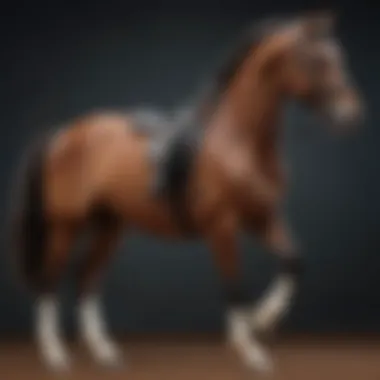
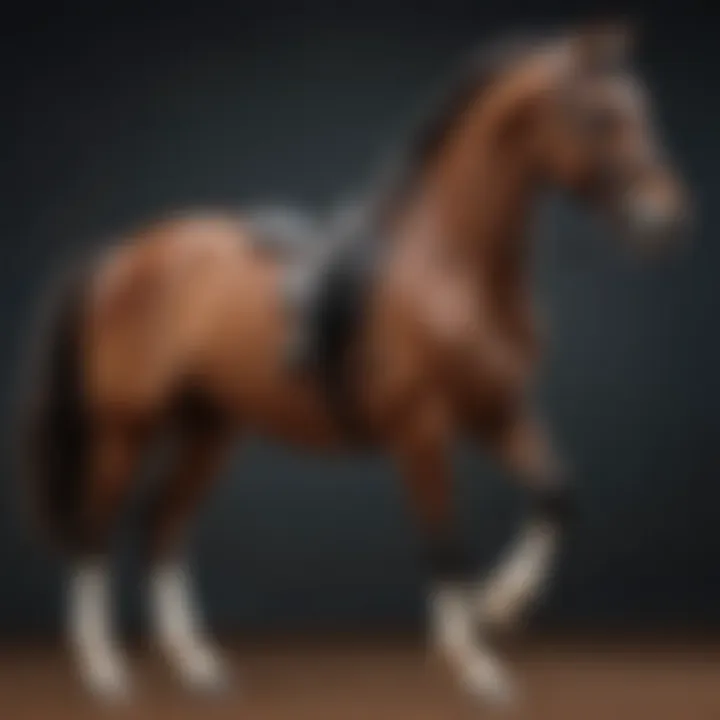
Educational Workshops and Seminars
Participation in educational workshops and seminars is another excellent resource for horse owners. These events typically feature expert speakers who discuss current practices in farriery and shoeing techniques. Workshops often provide hands-on demonstrations, which are crucial for deeper understanding.
Benefits of attending these sessions include:
- Up-to-date information on materials and techniques
- Networking opportunities with other horse owners and professionals
- Access to the latest research and case studies in farriery
Being informed about new trends and methodologies helps horse owners make educated choices. This leads to better care, as one can apply newly acquired knowledge when interacting with their farrier.
Understanding the nuances of hoof care for gaited horses can lead to improved performance and longer-lasting health. Regular consultations and learning opportunities provide horse owners with the tools needed for effective management.
Challenges in Shoeing Gaited Horses
Understanding the challenges in shoeing gaited horses is critical for ensuring their performance and well-being. These horses possess unique gaits and biomechanics that demand careful attention in handling hoof care. Improper shoeing can lead to significant issues, including pain, suboptimal performance, and long-term lameness. Thus, addressing these challenges not only benefits the horse but also enhances the overall experience for riders and trainers.
Common Issues Faced
Gaited horses often encounter several issues during the shoeing process. One prominent concern is the precision required in hoof trimming. Since these horses are bred for specific gaits, any variance in trimming can affect their movement adversely. Another common issue is finding shoes that are the appropriate weight and design. Gaited horses, such as the Tennessee Walking Horse or Missouri Fox Trotter, may require lighter shoes that allow for easy movement yet provide enough support.
Additionally, the hooves of gaited horses can display more unique shapes, which complicates the fitting process. Misalignment can happen without expert attention, causing discomfort and performance setbacks.
"Precision in shoeing directly translates to the horse's ability to perform its natural gaits efficiently."
Dealing with Behavioral Challenges
The behavioral challenges associated with shoeing gaited horses are notable. Some horses may exhibit stress or anxiety during the shoeing process. This can stem from previous negative experiences or general wariness around farriers. Furthermore, a horse's temperament may become an obstacle. For example, fidgety or skittish horses may be harder to handle, leading to safety risks for both the horse and the farrier.
To mitigate these behavioral issues, one effective approach is gradual desensitization. Familiarizing the horse with the tools and the shoeing environment can result in a calmer experience. Positive reinforcement during the process helps in building trust. This ultimately creates a more conducive atmosphere for shoeing. In some cases, it may be beneficial to work with a skilled farrier who understands the complexities of gaited horses' attitudes. Through patience and careful handling, farriers can successfully navigate these behavioral challenges while ensuring proper shoe application.
Trends in Gaited Horse Shoeing
Understanding trends in gaited horse shoeing is crucial for fostering optimal performance and health in these specialized athletes. Changes in materials and technology are shaping the farriery practices, directly influencing the welfare of gaited horses. Keeping abreast of these trends allows horse owners and farriers to make informed decisions that enhance the horse's movement and comfort.
Advancements in Shoeing Materials
Recent years have seen significant advancements in the materials used for shoeing gaited horses. Modern farriers are now utilizing lighter, more durable materials that can provide better grip and flexibility. For instance, specialty composite materials are becoming more popular. These materials can reduce the weight of the shoe, thereby minimizing fatigue during prolonged use.
Additionally, the introduction of shock-absorbing materials has transformed how shoes are constructed. This helps in reducing impact on the horse's legs, which is particularly beneficial for gaited breeds known for their unique movement patterns.
Benefits of advanced shoeing materials include:
- Weight reduction: A lighter shoe can lead to less physical stress on the horse.
- Improved traction: Enhanced materials can provide better grip on various surfaces, improving overall performance.
- Increased durability: New materials often last longer, reducing the frequency of shoeing and associated costs.
Integration of Technology in Farriery
Technology has also started to play a significant role in the shoeing of gaited horses. Tools such as digital hoof mapping and laser measurement systems help farriers to achieve precise measurements for shoe fitting. Digital platforms provide easy access to records of past shoeing, allowing for better tracking of changes over time.
Moreover, some farriers are now employing 3D printing technology for custom shoes, specifically designed for the individual needs of each horse. This innovation ensures a perfect fit and can address unique hoof characteristics or injuries.
Considerations surrounding technology in farriery include:
- Cost implications: While advanced technology can lead to better outcomes, initial investments can be high.
- Skill requirement: Farriers must be trained to use new technologies, which may require additional education.
- Adaptability: Horses may need time to adjust to new shoe types or materials; consideration of horse behavior is essential.
"Keeping abreast of trends in gaited horse shoeing ensures that owners and farriers work together to promote the welfare and performance of these extraordinary animals."
For further information, resources can be found on platforms like Wikipedia, Britannica and discussions can be followed on Reddit and Facebook.
Case Studies
Case studies play a crucial role in the understanding of shoeing gaited horses. They provide real-world examples that illustrate both successful and unsuccessful shoeing practices. Such studies emphasize the practical application of theoretical knowledge, showcasing how specific shoeing techniques impact the performance and overall well-being of gaited horses. In analyzing these cases, one can discern patterns, identify potential pitfalls, and appreciate the intricate relationship between shoeing and the unique biomechanics of gaited breeds.
Moreover, case studies often reveal critical insights that can lead to improved farriery practices. They allow professionals in the field to share knowledge, thus fostering a culture of continuous learning and adaptation. By examining both successes and failures, farriers can adjust their methodologies, benefitting not only individual horses but also influencing broader industry standards.
Successful Shoeing Interventions
Successful shoeing interventions serve as benchmarks within the field. One notable case includes a Tennessee Walking Horse that experienced significant improvement after a tailored shoeing program was implemented. Initially, the horse had difficulty maintaining its characteristic gait, which could be attributed to inadequate shoeing practices. A thorough assessment by a skilled farrier revealed that the previous shoes were not only the wrong type but were also improperly fitted.
After transitioning to custom aluminum shoes designed for enhanced traction, the horse showed remarkable improvement. Its gait became more fluid and rhythmic, demonstrating the profound impact of appropriate shoe choice and fitting. This case underscores the importance of individualized assessment in farriery.
Lessons Learned from Failures
While success is an important aspect, failures in shoeing gaited horses provide equally valuable lessons. A case involving a Missouri Fox Trotter highlighted the dangers of neglecting regular hoof care. The owner had opted for a one-size-fits-all approach, using generic shoes without considering the horse’s unique hoof shape and movement patterns. This led to chronic foot pain and a noticeable decline in performance.
Through diligent review of this case, farriers and owners alike have recognized the significance of continuous hoof evaluation and appropriate shoe selection. It is imperative to accept that every horse is distinct, and what may work for one might not work for another. Overall, these experiences contribute to a growing body of knowledge that can enhance the future practices of farriers working with gaited horses.



